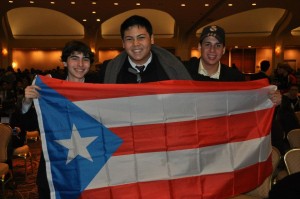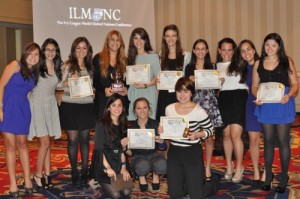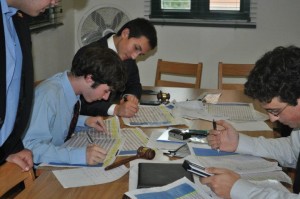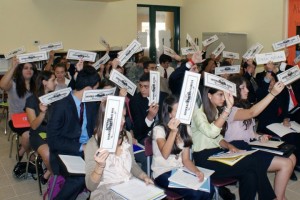This post is part of our series examining different Model UN circuits — we already did the West Coast, we’ll do Florida next, and here’s the one on the competitive Puerto Rican circuit.

Puerto Rican students Christopher Sang (Colegio Marista de Guaynabo), and Andrés Santiago (MASIS) proudly wave the Puerto Rican flag before closing ceremonies in NAIMUN XLIX. (Photo credit: Lamis Alkhatib)
No matter where they may be, the presence of a Puerto Rican Model United Nations team is felt throughout any conference it attends. This may have something to do with the extroverted and unabashed attitude we Puerto Ricans are known for, no matter how far away from home we may find ourselves. The spirit of Model UN has been firmly rooted in Puerto Rico, starting in the halls of any high school across the Island and continuing on to even the highest levels of government and industry. One would not be hard-pressed to find a member of the Governor’s cabinet who avidly participated in Model UN him or herself, including the Governor.
Politics in Puerto Rico is often considered the national pastime and, like baseball, the fervor it produces amongst the participants and spectators is first class entertainment. This love for politics that is so innate in Puerto Ricans, that it is easy to see why the platform that Model UN provides would be so attractive to young adults. Just like every player wants to hit a homerun, every delegate possesses a constant drive to win the coveted mallete (gavel), while still preserving the sense of camaraderie that truly defines our circuit. You’ll find a broad mix of every high school student archetype participating in Model UN. The Puerto Rican circuit is comprised of a diverse group of students who, often become lifelong friends, would otherwise never have had the chance to interact with each other.

Puerto Rican teams compete in two separate leagues: El Congreso and La Federacion. Regardless, teams from both leagues come into the mainland prepared to participate alongside the best Model UN delegates. Colegio Puertorriqueño de Niñas is shown here winning Best Small Delegation at ILMUNC 2012
It should be noted that when a Puerto Rican Model UN team travels abroad, it definitely undergoes a “culture shock.” The way the organization as we know it is run is quite distinctly, in my experience, from its stateside counterparts. Instead of selecting several independent conferences to attend in a year, there are two Model UN leagues on the Island: El Congreso (The Congress) and La Federación (The Federation). However, a select number of schools have opted to remain independent and attend the local conferences to which they are invited. As the TASIS Dorado Model UN team is a member of The Federation, I am better disposed to discuss its inner workings as opposed to those of the The Congress.
The Federation is composed of seven schools, where five host one competition each scholastic year for. Those that are to host in a given year are decided in a meeting the presidents, vice-presidents, and moderators of each school. Each school sends from one to two students from their school to each competition to act as chairpersons and structure the committee. To maintain fairness, two students from the same school may not chair together, instead spreading out among the four to five committees in the conference. Just as in the mainland, committees have ranged from customary UN bodies such as the General Assembly to national cabinets and specialized agencies. Everything is conducted in accordance with the Constitution established by the Federation.
There is a saying that is tossed around lightheartedly in Puerto Rico originating from an old tourism campaign that goes “Puerto Rico lo hace mejor” or “Puerto Rico does it better.” Whether there is truth to this statement in regards to Model UN, there do exist some noteworthy differences between Puerto Rican and stateside conferences. I can specifically comment on NAIMUN, since this is the conference the majority of The Federation schools attend. For better or for worse, us Puerto Ricans can be caught up in the “my way or the highway” mindset, which sometimes leads to some difficulty in stateside competitions. Nevertheless, we always prove ourselves versatile in any endeavor we undertake, but that doesn’t mean we will not speak our minds when we feel something is out of place, as many NAIMUN staffers realized!
The most distinguishing feature would be the scale of conferences. Many stateside conferences clearly dwarf Puerto Rican ones, which rarely top 300 delegates. This does, however, provide for a more interactive committee experience. In NAIMUN, I’ve noticed a much heavier focus on what we call “delegating”—the backroom deal making process that transpires for the purpose of passing resolutions and such whereas in Puerto Rico, committee is undoubtedly centered around fast paced debate in moderated caucuses. This is also more feasible in smaller conferences such as our own, where conferences here last only two days
Additionally, the variation in parliamentary procedure has, upon occasion, led to some confusion among our delegates! While fundamentally the same, certain concepts such as time yields and resolution amendments are virtually nonexistent in the Puerto Rican circuit due to the fast-paced format. The agenda and speakers list take on roles distinct from those in the States, as well. Nevertheless, what strikes most Puerto Ricans as the biggest departure in how the conferences are run is the absence of a concrete rubric for determining awards.

The chairs tally up the scoresheets. This is similar to the competitive West Coast circuit that uses scoresheets and high school chairs, except in Puerto Rico the chairs are from different schools in the league instead of from one hosting school. (Photo credit: Rawan Alkhatib)
The Federation has always utilized a point system for this end, and recently developed a specific rubric and page system to maximize efficiency. The rubric is divided into ten sections, ranging from the quality of the position paper to consistency in debate to diplomacy points. Instead of suffocating the chairpersons, however, this rubric serves as an effective tool for them to guide committee. The manner in which points are awarded depends on the structure of the committee and what its chairs deem necessary. The Federation is committed to transparency, so by a conference’s conclusion, all graded position papers and score sheets should be available to delegates and moderators per their request.
I am convinced that the Puerto Rican and mainland circuits can learn from each other in order to improve the quality of their Model UN conferences. If we felt that we had nothing to gain from attending conferences such as NAIMUN, ILMUNC, and HMUN, we would not have institutionalized the tradition of attending one of these conferences every year. In turn, as Puerto Ricans continue to bring home masses of awards—testimonies to our commitment to hard work—I hope our counterparts in the fifty States and elsewhere recognize us a force to be contended with in Model United Nations.
What do you think about Model UN in Puerto Rico? Let us know in the comments!



